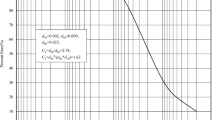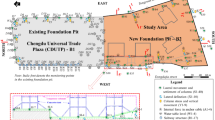Abstract
The paper reports a study of the cause of defects in light structures and the toppling of a wall constructed on a fill material rich in Ankara clay. Laboratory tests were carried out on vertical and horizontal samples from boreholes and a trial pit was excavated near the damaged structures. The results showed that in the vicinity of the toppled wall, swelling pressures in the horizontal direction were greater than those measured in the vertical direction. The swelling properties of the fill material were higher than those of original Ankara clay as determined previously by other investigators, suggesting that breakdown of the cementing bonds and a change in the fabric are the main factors affecting the swelling pressure of disturbed and compacted expansive soils. The calculations to predict uplift showed a good agreement with the observations in the damaged structures. It is concluded that swelling was the main cause of the damage to the light structures at the study site and resulted from the highly expansive nature of the fill material, poor drainage, the semi-arid climate, poor construction methods and ineffective precautions. Some recommendations for minimizing the effects of swelling at the study site are briefly outlined.
Résumé
L’article présente une étude sur les causes de défauts dans des structures légères et le basculement d’un mur, ouvrages construits sur des matériaux de remblai contenant de l’argile d’Ankara. Des essais de laboratoire ont été réalisés sur des échantillons prélevés en sondage et découpés verticalement ou horizontalement. Une tranchée d’observation fut excavée près des structures endommagées. Les résultats ont montré qu’à proximité du mur basculé, les pressions de gonflement dans la direction horizontale étaient plus fortes que dans la direction verticale. De plus, les propriétés de gonflement du matériau de remblai étaient plus importantes que celles de l’argile d’Ankara intacte, suivant les mesures faites antérieurement par d’autres chercheurs, ce qui suggère que la disparition des liens de cimentation et la modification de la microstructure sont les facteurs principaux qui contrôlent la pression de gonflement des sols gonflants remaniés et compactés. Les calculs réalisés pour prévoir le gonflement ont montré un bon accord avec les observations faites sur les structures endommagées. On conclut que le gonflement des sols de fondation était la cause principale des dommages affectant les structures légères sur le site d’étude et que ces dommages résultaient de la nature fortement gonflante des matériaux de remblai, du faible drainage du terrain, du climat semi-aride et des méthodes de construction peu adaptées au terrain. Des recommandations pour minimiser les effets du gonflement sur le site d’étude sont brièvement données.














Similar content being viewed by others
References
AFNOR (L’Association Francaise De Normalisation) (1980) Essai au bleu de methylene. P18-592, AFNOR 80181, Paris La Defence
Al-Homoud AS, Al-Suleiman TI (1997) Loss in serviceability of pavements due to expansive clay subgrades. Environ Eng Geosci III (1):277–294
ASTM (2000) Annual book of ASTM standards—soil and rock, building stones, Section 4, Construction, v. 04.08. ASTM Publication, Philadelphia, USA
Avsar E, Ulusay R, Erguler ZA (2005) Swelling properties of Ankara (Turkey) clay with carbonate concretions. Environ Eng Geosci XI (1):75–95
Avsar E, Ulusay R, Sonmez H (2009) Assessments of swelling anisotropy of Ankara clay. Eng Geol 105:24–31
Basma AA (1991) Estimating uplift of foundations due to expansion: a case history. Geotech Eng 22:217–231
Bell FG, Maud RR (1995) Expansive clays and construction, especially of low-rise structures: a viewpoint from Natal, South Africa. Environ Eng Geosci I (1):41–59
Birand AA (1963) Study of the characteristics of Ankara clays showing swelling properties. M.Sc Thesis, Department of Civil Engineering, Middle East Technical University, Ankara, Turkey
Bowles JE (1989) Foundation analysis and design, 4th edn. McGraw Hill, New York
Chen FH (1988) Foundations on expansive soils. Elsevier, Amsterdam, the Netherlands
Claudia M (2000) Predicting swelling/shrinkage potential using the methylene blue method: some examples in Italian clayey soils. GeoEng 2000, International Conference on Geotechnical and Geological Engineering, Melbourne, Australia (on CD)
Cokca E (1991) Swelling potential of expansive soils with a critical appraisal of the identification of swelling of Ankara soils by methylene blue tests. PhD Thesis, Department of Civil Engineering, Middle East Technical University, Ankara, Turkey
Cokca E, Birand AA (1993a) Determination of cation exchange capacity of clayey soils by the methylene blue test. Geotech Test J 16(4):518–524
Cokca E, Birand AA (1993b) Prediction of swelling potential of Ankara soils by methylene blue test. DOGA Turkish J Eng Environ Sci 17:57–63
Day RW (1996) Study of capillary rise and thermal osmosis. J Environ Eng Geosci, Joint Publ, AEG and GSA 2(2):249–254
Day RW (2006) Foundation engineering handbook. McGraw-Hill, New York, USA
Derriche Z, Iguechtal L (2000) Damage due to swelling soils in the region of In-Amenas: Algeria. GeoEng 2000, International Conference on Geotechnical and Geological Engineering, Melbourne, Australia (on CD)
Du Y, Li S, Hayashi S (1999) Swelling–shrinkage properties and soil improvement of compacted expansive soil, Ning-Liang Highway, China. Eng Geol 53:351–358
Erguler ZA, Ulusay R (2003a) Engineering characteristics and environmental impacts of the expansive Ankara clay, and swelling maps for SW and central parts of the Ankara (Turkey) metropolitan area. Environ Geol 44(8):979–992
Erguler ZA, Ulusay R (2003b) A simple test and predictive models for assessing swell potential of Ankara (Turkey) Clay. Eng Geol 67:331–352
Fityus SG, Smith DW, Jennor AM (2000) Surface area using methylene blue adsorption as a measure of soil expansivity. GeoEng 2000, International Conference on Geotechnical and Geological Engineering, Melbourne, Australia (on CD)
Furtun U (1989) An investigation on Ankara soils with regard to swelling. MSc Thesis, Department of Civil Engineering, Middle East Technical University, Ankara, Turkey
Gundogdu MNG (1982) Geological, mineralogical and geochemical investigation of the Neogene aged Bigadic sedimentary basin. PhD Thesis, Department of Geological Engineering, Hacettepe University, Ankara, Turkey (in Turkish)
Hang PT, Brindley GW (1970) Methylene blue adsorption by clay minerals, determination of surface area and cation exchange capacities, Clay Organic Studies XVIII. Clays and Clay Minerals 18:203–221
Holtz WG, Gibbs H (1956) Engineering properties of expansive clays. Transact Am Soc Civil Eng 121:641–677
Magngira MB, Paige-Green P (2008) Evaluation of damage to a road and sports complex on expansive clays. In: Proceedings of the 6th International conference on case histories in geotechnical engineering, Arlington, VA, Paper No. 8.08b, pp 1–11
Meisina C (2002) Swelling/shrinkage hazard assessment applications in Italy. In: Proceedings of the 9th Congress of International Association for Engineering Geology and Environment, Durban, South Africa, pp 625–635
Meyerhof GG (1953) The bearing capacity of foundations under eccentric and inclined loads, Proceedings, 3rd International conference on soil mechanics and foundation engineering, Zurich, vol 1., No 1, pp 440–445
Nelson JD, Miller DJ (1992) Expansive soils, problems and practice in foundation and pavement engineering. Wiley, New York
Nevins MJ, Weintritt DJ (1967) Determination of cation exchange capacity by methylene blue adsorption. Ceramic Bull 46(4):587–592
O’Neill MW, Poormoayed M (1980) Methodology for foundations on expansive clays. J Geotech Eng Divison, ASCE 106(GT12):5–1367
Omay B (1970) Swelling clays on METU campus. MSc Thesis, Department of Civil Engineering, Middle East Technical University, Ankara, Turkey
Ordemir I, Alyanak I, Birand AA (1965) Report on Ankara Clay. METU Publication No. 12, Ankara, Turkey
Ordemir I, Soydemir C, Birand AA (1977) Swelling problems of Ankara clays. In: Proceedings of the 9th international conference on soil mechanics and foundation engineering, vol 1. Tokyo, Japan, pp 243–247
Popa A (1997) Shrinkage-swelling phenomena effects on building. Proceedings of the international symposium on engineering geology and the environment, Athens, Greece. Balkema, Rotterdam, pp 327–329
Popescu ME (1979) Engineering problems associated with expansive clays from Romania. Eng Geol 14:43–53
Shi B, Jiang H, Liu Z, Fang HY (2002) Engineering geological characteristics of expansive soils in China. Eng Geol 67:63–71
Sivapullaiah PV, Sitharam TG, Rao KSS (1987) Modified free swell index for clays. Geotech Test J 10(2):80–85
Sowers GF (1979) Soil mechanics and foundations: geotechnical engineering, 4th edn. Macmillan, New York
Tang AM, Cui YJ, Trinh VN, Szerman Y, Marchadier G (2009) Analysis of the railway heave induced by soil swelling at a site in southern France. Eng Geol 106:68–77
Ulusay R (1975) Geo-engineering properties of north-central part of Ankara City. M.Sc Thesis, Department of Geological Engineering, Hacettepe University, Ankara, Turkey (in Turkish)
Uner AK (1977) A comparison of engineering properties of two soil types in the Ankara region. MSc Thesis, Department of Civil Engineering, Middle East Technical University, Ankara, Turkey
Van der Merve DH (1964) The prediction of heave from the plasticity index and the percentage clay fraction. The Civil Eng (S Afr Inst Civil Eng) 6:103–107
Acknowledgments
It is a pleasure for the authors to acknowledge the logistic support of Fatih Adil during the borings. The authors also specially thank the General Directorate of Meteorology for providing the rainfall data, Prof. Dr. Abidin Temel of the Geological Engineering Department at Hacettepe University for his kind help with XRD analyses and Semih Senkan (graduate student of Gazi University) for his help during the sampling and testing stages of the study.
Author information
Authors and Affiliations
Corresponding author
Rights and permissions
About this article
Cite this article
Ozer, M., Ulusay, R. & Isik, N.S. Evaluation of damage to light structures erected on a fill material rich in expansive soil. Bull Eng Geol Environ 71, 21–36 (2012). https://doi.org/10.1007/s10064-011-0395-2
Received:
Accepted:
Published:
Issue Date:
DOI: https://doi.org/10.1007/s10064-011-0395-2




